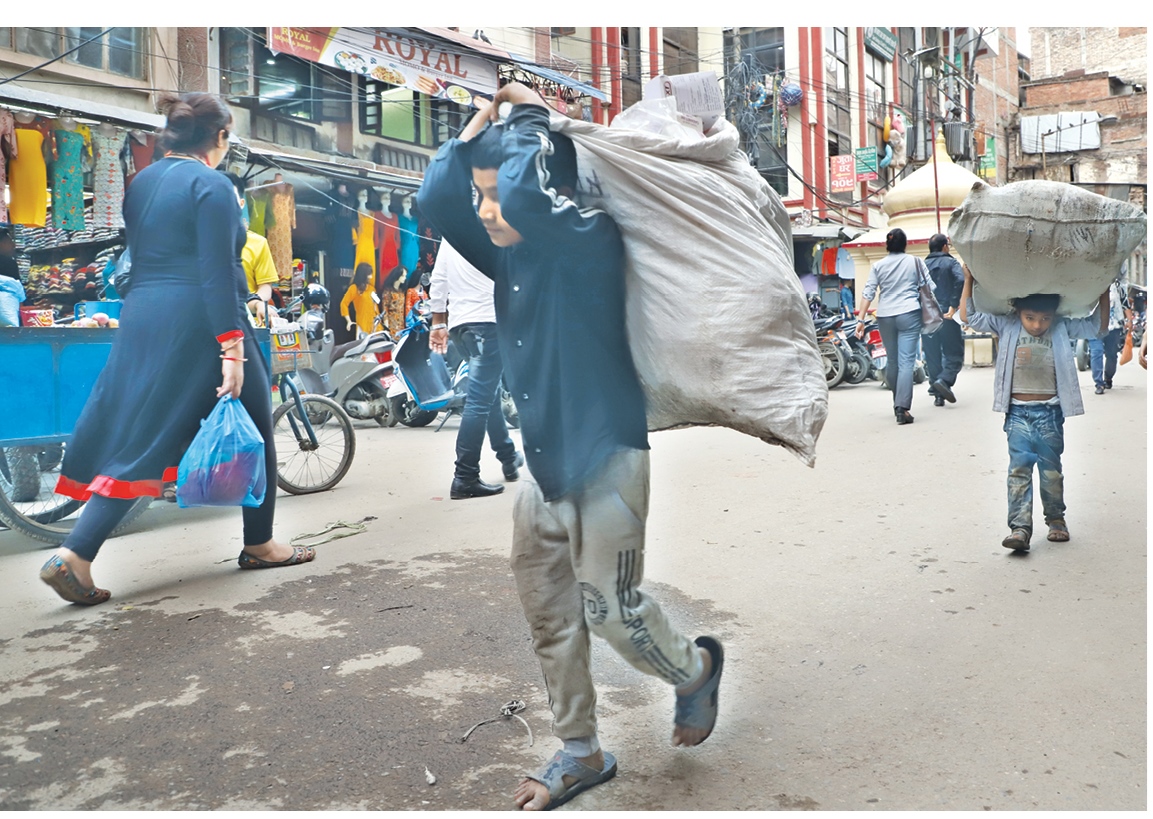Kathmandu: Mini abroad for many underprivileged

Couple of months back, I was waiting for a scrap collector in front of my room with whom I had come in contact through a phone call. A friend of mine had given my contact to the scrap collector because I needed to remove the old newspapers and note copies from my room.
Never seen before, I waited for him to arrive in a place we had decided over the call. But when he arrived, he shocked me. I had not expected him to be a boy barely 15 years old. He had come along with his friend of the same age.
When I took the duo to my room, they started putting newspapers in their sacks and I asked them for their reason for coming to Kathmandu at such a small age and working as a scrap collector.
“Because, Kathmandu is abroad for us,” one replied while the other looked at me and nodded his head supporting what his friend had said. After a pause, the boy added, “There is nothing and no one at home so we decided to come to Kathmandu and earn our livelihood.”
The duo hailed from Rautahat and it had been six months since they entered their abroad and started collecting scraps. It is child labour but for the two boys, Kathmandu gave what they wanted – job.
When they were leaving, I asked them if they were happy with their abroad but the boy who cited Kathmandu as abroad said he wasn’t. “It (Kathmandu) has a lot to provide but many more to take care of. It is unorganised. If there was something I could do to earn in my home, I would not hesitate to return,” he said while walking down the stairs.
For years, Kathmandu has been a place for opportunity and better services for thousands of Nepalis. With people arriving in Kathmandu for better education, health, job placement and various other quality facilities, the number has not decreased despite the country starting to exercise federalism.
For the last two years, governments have been in place in all seven States, but they not been able to achieve its major objective of decentralisation with the streets of Kathmandu being its proof.
I remember cycling freely on the inner roads of Ghattekulo a decade ago.
But today, those inner roads are occupied with vehicles and the main roads scenario is well-known.
“It was before Dashain when I came to Kathmandu for the first time. I had reached at night and it was so peaceful. Next morning I woke up and Kathmandu made me feel like returning home,” said Dipen Khadka, a 19-year-old from Morang who came to Kathmandu to pursue better education.
Automobiles have taken over various parts of the country, even though when many places await connection, and the way it has occupied Kathmandu it has not occupied any other places. The reason cannot be other than overpopulation.
But despite the overpopulation, Kathmandu’s capacity of holding it is incomparable. Yet, it has not done what it needs to.
“Kathmandu has been able to keep such a huge population with such minimum infrastructure. It needs to do more, hasn’t done many but is starting few,” said Aaditya Bhandari, a 4th year civil engineering student at Janakpur Engineering College who likes to research possible upgrades that can be done in Kathmandu.
Regardless of the major metropolis of the country, Kathmandu was one of the last local bodies to be Open Defecation Free (ODF) when the government rushed to declare Nepal as ODF free country within the said deadline, which was extended once due to the 2015 devastating earthquake.
Faeces are visible over the over-head bridges of the Ratnapark-Sundhara area and the lack of public toilets is still a major problem.
Experts say that water is the most essential part of sanitation and its scarcity is well-faced in Kathmandu. The scarcity is, however, suppressed with Melamchi promises.
It is hard to say how Kathmandu would be in the upcoming years. If the government could create better services of health, education, transportation and job among others in all the seven states, decentralisation could make Kathmandu peaceful again and develop the whole nation together.
“Regarding infrastructure development, there are more than enough possibilities waiting to be executed outside the Kathmandu Valley and similarly inside it. If the government could reduce the recent population through managed decentralisation, many things can be done in Kathmandu,” said Bhandari.
Recent News

Do not make expressions casting dout on election: EC
14 Apr, 2022
CM Bhatta says may New Year 2079 BS inspire positive thinking
14 Apr, 2022
Three new cases, 44 recoveries in 24 hours
14 Apr, 2022
689 climbers of 84 teams so far acquire permits for climbing various peaks this spring season
14 Apr, 2022
How the rising cost of living crisis is impacting Nepal
14 Apr, 2022
US military confirms an interstellar meteor collided with Earth
14 Apr, 2022
Valneva Covid vaccine approved for use in UK
14 Apr, 2022
Chair Prachanda highlights need of unity among Maoist, Communist forces
14 Apr, 2022
Ranbir Kapoor and Alia Bhatt: Bollywood toasts star couple on wedding
14 Apr, 2022
President Bhandari confers decorations (Photo Feature)
14 Apr, 2022











